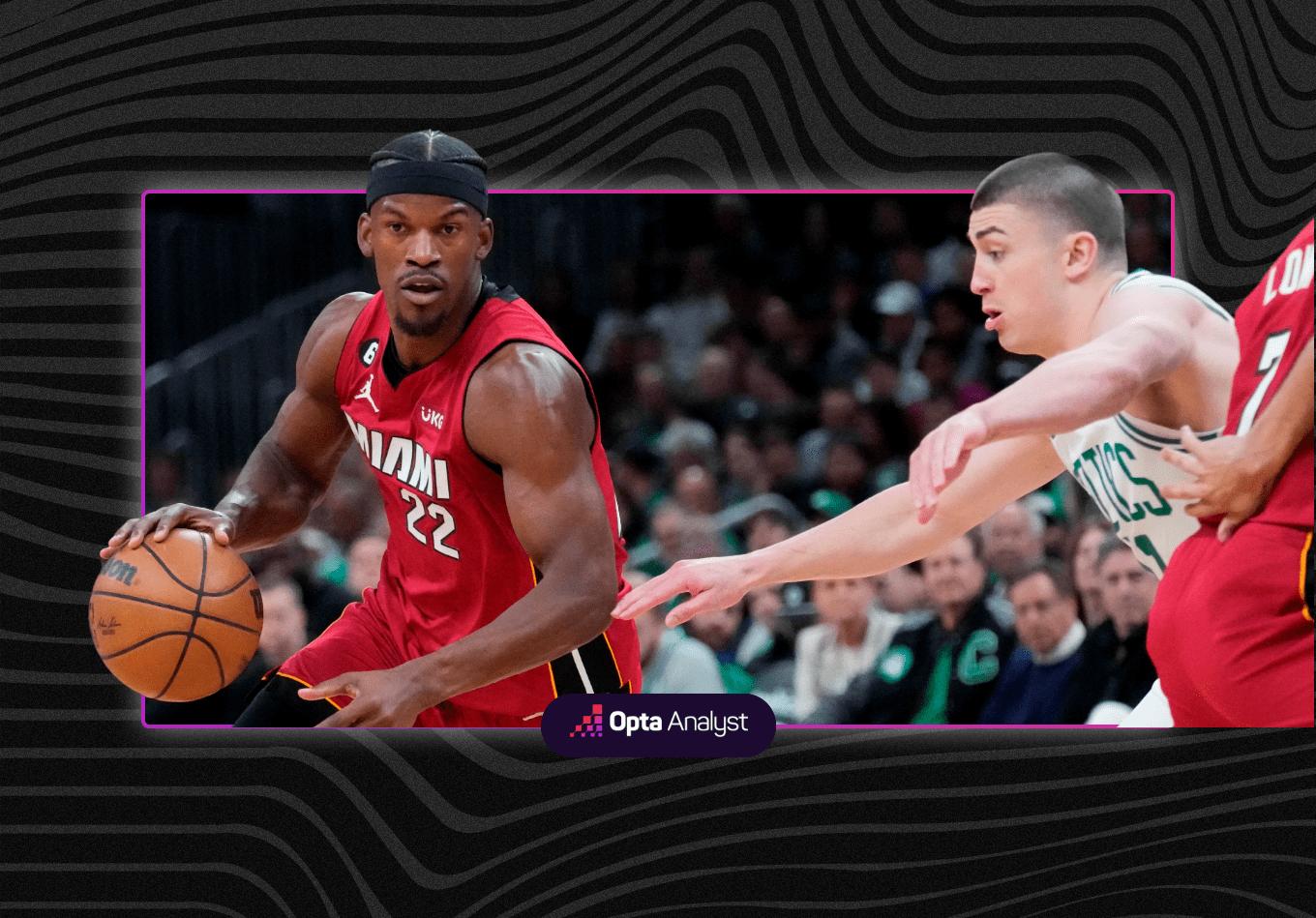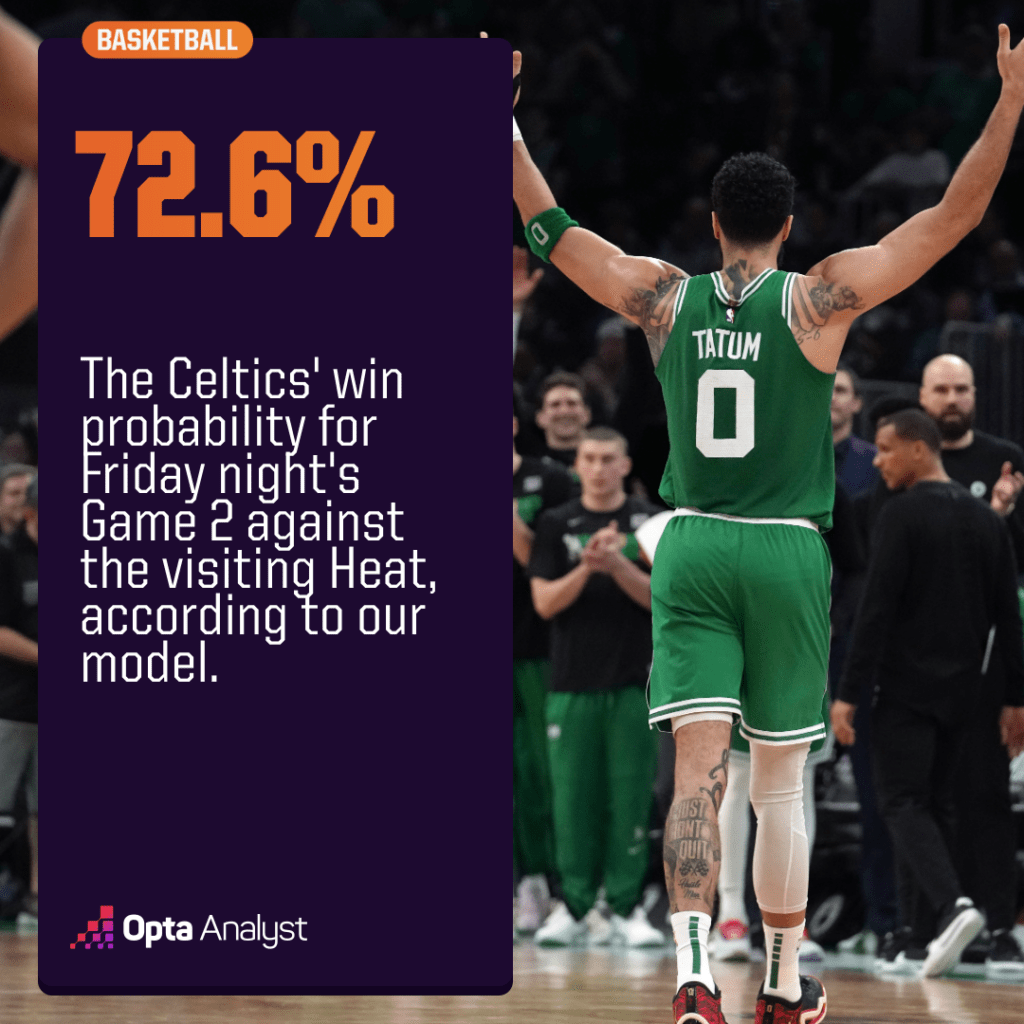Celtics vs Heat Game 2 Prediction: Can Miami Take a 2-0 Lead?
 NBA
May 18, 2023
NBA
May 18, 2023
After falling behind by as many as 12 points, the Miami Heat managed to come out of Game 1 against the Boston Celtics with a seven-point victory.
The win represented a proud moment for Heat fans and a true display of perseverance. But to many around the league, this triumph merely signaled a delay in the Celtics’ inevitable march to the NBA Finals.
And rightfully so, even after taking a 1-0 series lead on the road, the Heat still only have a 30.8% chance of advancing to the last stage of the tournament (according to our playoff model). That is a step up from the original 13.7% chance they had prior to the start of the series, but still only a puncher’s chance at best.
But as many of us are surely well aware of at this point, the Miami organization doesn’t believe in odds. The Heat believe in themselves. And in Game 1, that rag-tag group of misfits may have just carved out the blueprint for pulling off yet another series upset.
Beat Them at the Top EndJoe Mazzulla has, without question, the deepest team in basketball. The Celtics are the only team in the league with eight players touting a DRIP score of plus-0.1 or higher (minimum 800 minutes played). For comparison, the Heat only have six such players that fit this criteria.
When you are at such a stark disadvantage in the depth category, you need to make up for it at the top end. That was the case last round for the Philadelphia 76ers. They needed James Harden and MVP Joel Embiid to be two of the three best players in the series. That didn’t happen consistently enough, and now they are at home watching the series. Now the Heat need Jimmy Butler and Bam Adebayo to be two of the three best players in this series.
Opta Analyst’s Player Projections – Heat Jimmy Butler: 27.50 points, 6.32 rebounds, 5.86 assists, 0.89 3s, 2.26 steals, 0.52 blocks Bam Adebayo: 19.72 points, 8.86 rebounds, 1.27 steals, 0.85 blocks Max Strus: 11.83 points, 2.72 3s Kyle Lowry: 10.40 points, 4.50 assists, 1.88 3s, 1.05 steals, 0.53 blocks Gabe Vincent: 9.47 points, 1.94 3s, 0.93 stealsYou know Playoff Jimmy is always bringing the heat (no pun intended). In Game 1, Butler dropped 35 points, seven assists, and six steals while only taking 25 shots from the floor and posting a plus/minus of +5.
The real question marks were the ones surrounding his co-star. Adebayo is always an elite contributor on the defensive side of the ball (he’s now a four-time All-NBA defender). But he’s often criticized for his lack of assertiveness at the other end of the floor.
Those concerns reared their ugly head in the last conference finals, as Adebayo went from fourth on the team in the regular season in usage rate (25%) to 10th during that series (16.9%) against the Celtics.
Now, don’t get it twisted. Adebayo does not need to average 25 points per game. That is not the type of player he is. But he does need to be able to do three things for Erik Spoelstra:
1) punish defenses for sagging off of him 2) use his strength to attack mismatches on the interior 3) be enough of a scoring threat to draw a second defender and create an easier shot for his teammateLet’s see how he did in those areas in Game 1:
Check, check, and check.
For the game, he finished with 20 points, eight rebounds, five assists, and one steal. He took 13 shots from the floor, but most importantly, the Heat were a +18 in his minutes (a game high).
Be Your Best SelfThe Celtics’ key offensively (third in our adjusted offensive ratings during the regular season) is the spacing and versatility of their five-out lineups.
When Al Horford is on the floor for Robert Williams at center, all five guys for Boston can shoot, drive and kick. When they are firing at all cylinders, they are practically unstoppable because they will drive and kick until they get a shot at the rim if you don’t send any help toward the paint.
The kicker is, if you do send help, they will spray the ball out to one of their open shooters on the perimeter.
Opta Analyst’s Player Projections – Celtics Jayson Tatum: 29.94 points, 9.38 rebounds, 4.63 assists, 3.57 3s, 1.16 steals, 0.92 blocks Jaylen Brown: 24.59 points, 6.18 rebounds, 2.54 3s, 1.11 steals Malcolm Brogdon: 15.25 points, 4.23 rebounds, 3.62 assists, 2.31 3s Marcus Smart: 13.50 points, 6.21 assists, 2.31 3s, 1.67 steals Derrick White: 11.16 points, 1.87 3s, 0.88 blocks Al Horford: 9.34 points, 7.01 rebounds, 2.40 3s, 0.88 steals, 1.48 blocks Robert Williams: 8.46 points, 8.4 rebounds, 0.75 steals, 1.65 blocksThe key to slowing down this leviathan of an offense is stopping them from firing on all cylinders. How do you do that? Simple (not really), you need to disrupt their offensive flow. You need to force turnovers.
That is why we captioned the heading of this section “Be your Best Self.” The Heat’s entire MO on defense is that they love to junk you up, and they love to force turnovers. They have finished each of the last three regular seasons in the top three in opponent turnover percentage.
The tradeoff to the Celtics’ ultra-versatile five-out lineups is that they hardly ever harbor a “true” point guard who is capable of steadying the offense. So by attacking their ball handlers’ dribble (first and second clip) and shrinking their passing lanes (third clip) you can muck up their offensive flow.
While the Heat force Boston to make mistakes, they also need to be mindful that they don’t cough up the ball when it’s their turn either. Miami doesn’t boast the well-oiled machine that Boston has (they were only 21st in adjusted offensive rating), so they don’t have the margin for error to be giving away possessions.
That formula of forcing Boston to make mistakes while simultaneously limiting their own was a key ingredient in their Game 1 turnaround. In the first half, when Boston was winning by nine, Miami had nine turnovers compared to the Celtics’ five. In the second half, when the Heat outscored Boston by 16, they only had three turnovers compared to 10 by the Celtics.
(Sidebar: The Heat only had one turnover during their monster 45-point third quarter.)
Sometimes It Is Better to Be Lucky Than GoodWe know what you’re thinking. How could he go this long without mentioning the fact that Miami shot 51.6% from 3-point range? That is not sustainable for an entire series!
Simmer down, my friend. Simmer down. A couple of things about the white-hot 3-point shooting that Miami exhibited in Game 1. First off, theoretically, the form of bonkers outside shooting is semi-sustainable in a postseason series. After all, Miami literally just shot 45% from downtown in the first round against the Milwaukee Bucks. So technically, the Heat have proven capable of this type of shooting in the past.
Second, everyone wants to talk about how Miami was 27th in the regular season (34.4%) in 3-point percentage. But no one wants to point out how the Heat were first in 3-point efficiency (37.9%) with pretty much the same personnel in the year prior. So why is it that everyone assumes that Miami is bound to regress? What if these NBA playoff games are just the Heat re-establishing their elite marksmanship from last year?
Third, if you look through their made 3s from Game 1, many of them were relatively open looks that they created through exquisite ball movement and advantage creation.
According to NBA.com, 25 of the Heat’s 31 3s in Game 1 were open/wide-open shots, meaning only six were tightly contested. In terms of accuracy, they missed all those tightly contested looks and went 16 for 25 on those open/wide-open shots.
Now, they likely won’t convert on 64% of their open/wide-open 3s moving forward, but at least they are hitting the 3s that are the result of good offensive process rather than the ones that come from late-clock prayers.
The fourth and final point that needs to be made regarding the Heat’s shooting: When you’re a massive underdog, you need a little bit of luck on your side. To beat the Goliath Celtics, Miami can’t afford to shoot 30.6% from 3 as it did against the New York Knicks. To mask their talent deficiencies, the Heat need to be closer to that 45% mark they shot against Milwaukee.
At the end of the day, they need a little luck to emerge from the conference finals unscathed. But who cares about a little luck if it helps you get to the NBA Finals?
Game 2 Win ProbabilityIn terms of the moneyline, sportsbooks have the Celtics, who have home-court advantage at the TD Garden, as the best bets (-400) in this matchup and the Heat as the underdogs (+320) Friday night on TNT.
But who does our model project to win Game 2 of the Eastern Conference finals?

This model calculates win probability based on thousands of simulations. It incorporates the rankings from our adjusted team ratings (including overall adjusted team rating, adjusted offensive rating and adjusted defensive rating), accounts for recency bias (so, it gives more weight to teams playing well) and for how well teams have performed against other good teams.
For Game 2, the model favors the Celtics (72.6%). They had the league’s best overall adjusted team rating heading into the series, though the Heat are second in adjusted defensive rating improvement from the regular season to playoffs behind only LeBron James and the Los Angeles Lakers.
Like this? Follow us on Twitter for more.


































